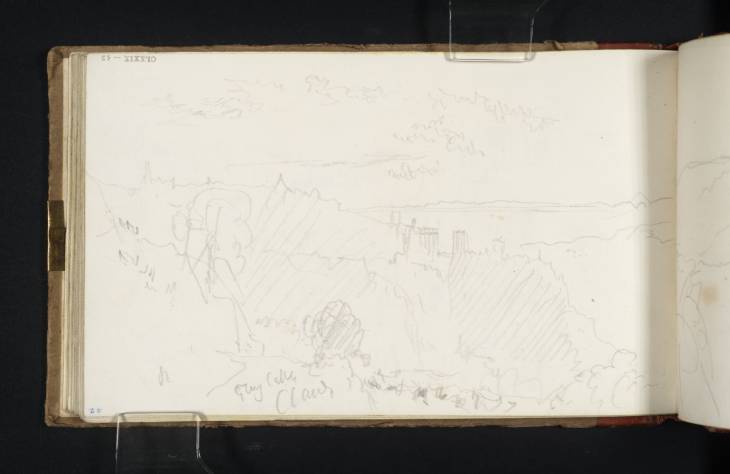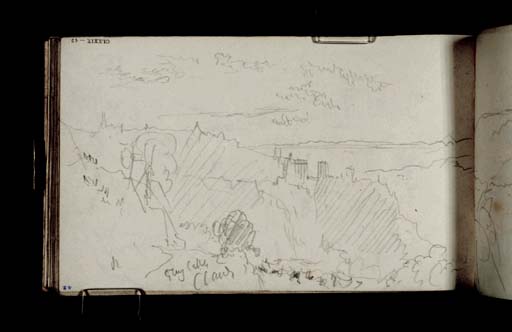Joseph Mallord William Turner View of Tivoli at Sunset, with the So-Called Temples of Vesta and the Sibyl 1819
Image 1 of 2
Joseph Mallord William Turner,
View of Tivoli at Sunset, with the So-Called Temples of Vesta and the Sibyl
1819
Joseph Mallord William Turner 1775–1851
Folio 42 Recto:
View of Tivoli at Sunset, with the So-Called Temples of Vesta and the Sibyl 1819
D15004
Turner Bequest CLXXIX 42
Turner Bequest CLXXIX 42
Pencil on white wove paper, 112 x 186 mm
Inscribed by the artist in pencil ‘Grey Cattle | Claude’ bottom centre left
Inscribed by ?John Ruskin in blue ink ‘42’ bottom left, inverted
Stamped in black ‘CLXXIX 42’ top left, inverted
Inscribed by the artist in pencil ‘Grey Cattle | Claude’ bottom centre left
Inscribed by ?John Ruskin in blue ink ‘42’ bottom left, inverted
Stamped in black ‘CLXXIX 42’ top left, inverted
Accepted by the nation as part of the Turner Bequest 1856
Exhibition history
2000
Pure as Italian Air: Turner and Claude Lorrain, Tate Britain, London, November 2000–April 2001 (no catalogue).
2002
Turner et le Lorrain, Musée des beaux-arts, Nancy, December 2002–March 2003 (41, reproduced in colour).
References
1909
A.J. Finberg, A Complete Inventory of the Drawings of the Turner Bequest, London 1909, vol.I, p.528 as ‘A hilly landscape, &c. (probably Tivoli). “Grey Castle. Claude”; also sketch of Plautian Tomb, Tivoli’.
1984
Cecilia Powell, ‘Turner on Classic Ground: His Visits to Central and Southern Italy and Related Paintings and Drawings’, unpublished Ph.D thesis, Courtauld Institute of Art, University of London 1984, pp.174 note 17, 176 note 25.
1985
Jack Lindsay, Turner: The Man and His Art, London 1985, p.96.
1977
Gerald Wilkinson, Turner Sketches 1789–1820, London 1977, p.[158].
1987
Cecilia Powell, Turner in the South: Rome, Naples, Florence, New Haven and London 1987, pp.74 note 5, [77] note 15.
1990
Kathleen Nicholson, Turner’s Classical Landscapes: Myth and Meaning, Princeton 1990, p.262 [as CLXXIX 41–41a in error].
2002
Ian Warrell, Turner et le Lorrain, exhibition catalogue, Musée des beaux-arts, Nancy 2002, no.41, pp.95, 191, reproduced, as ‘View of Tivoli (with a detail of the Tomb of the Plautii)’.
2003
David Hill, ‘J.M.W. Turner: From the World to Art and Back Again: The 2003 Kurt Pantzer Memorial Lecture’, in Turner Society News, no.95, December 2003, pp.12, 16 note 32.
Turner sketched this distant view of Tivoli from a point on the present-day Via Quintilio Varo, on the lower slopes of Monte Catillo to the north-east of the town. Visible in the centre of the composition are the silhouettes of the so-called Temple of Vesta and Temple of the Sibyl, perched on the edge of the steep gorge, whilst to the left is the campanile of the Cathedral (Duomo) of San Lorenzo. The hasty character of the lines and the areas of hatched shading suggest that the artist was sketching at the end of the day when the light was failing and parts of the landscape were cast into deep shadow. The sketch is continued on the opposite sheet of the double-page spread, see folio 41 verso (D15003). Turner made several sketches from this viewpoint, see folios 40–42 verso and 87 verso (D15000–D15005 and D15092), the Tivoli sketchbook (Tate D15468, D15488, D15500–D15502; Turner Bequest CLXXXIII 2, 22, 33–5), and in the Naples: Rome C. Studies sketchbook (Tate D16116 and D16118; Turner Bequest CLXXXVII 28 and 30). He also repeated the vista during his 1828 visit to Tivoli, see the Roman and French sketchbook (Tate D21912; Turner Bequest CCXXXVII 35a). The composition is similar to that of Turner’s early oil painting, Tivoli and the Roman Campagna circa 1798 (Tate, N05512),1 which was itself based upon a version of a picture by the eighteenth-cntury Welsh artist, Richard Wilson (1713–1782), for example, Temple of the Sibyl and the Roman Campagna circa 1765–70 (Tate, T01706).
The picturesque spectacle of the ancient temple seen in its dramatic natural setting against the contre-jour of sunset, seems to have fitted Turner’s preconceived ideas about the artistic representation of Tivoli. In the bottom left-hand corner he has invoked the name of the seventeenth French master, Claude Lorrain (circa 1604/5–1682), the artist whose idealised representations of the Roman Campagna represented the greatest influence on Turner’s understanding of Italianate landscape. This sketch assumes the same vantage point as that of Claude’s drawing View of Tivoli circa 1640–1 (British Museum), an engraving of which appeared in Richard Earlom-Boydell’s third volume of the Liber Veritatis in 1819, the year Turner set out on his Italian travels.2 Inscriptions on other pages of this sketchbook reveal that Turner also associated Tivoli with the work of Wilson and Gaspard Dughet (1615–1675), see folios 41 and 56 (D15002 and D15030).
Finberg and other scholars have previously interpreted the inscription at the bottom of the page as ‘Grey Castle’, but Ian Warrell has most recently corrected this to ‘Grey Cattle’.3
Nicola Moorby
February 2010
How to cite
Nicola Moorby, ‘View of Tivoli at Sunset, with the So-Called Temples of Vesta and the Sibyl 1819 by Joseph Mallord William Turner’, catalogue entry, February 2010, in David Blayney Brown (ed.), J.M.W. Turner: Sketchbooks, Drawings and Watercolours, Tate Research Publication, December 2012, https://www


